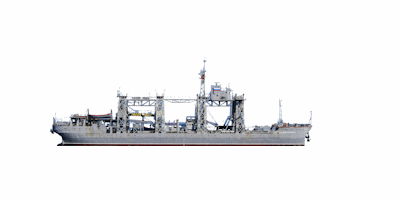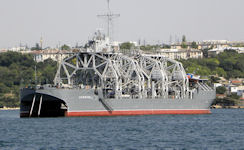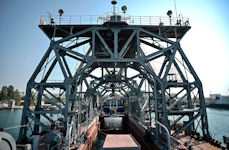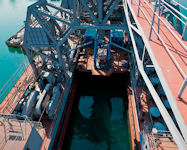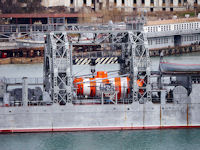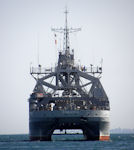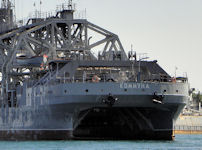Kommuna ex-Volkov - salvage ship
Laid down as the Volkhov (now Kommuna) submarine salvage ship in 1912, it was launched the next year, and in 1915 joined the Baltic Fleet. Constructed in the Russian Empire, this vessel took part in both World Wars and continues to serve today on a par with modern ships. It’s unbelievable, but this century-old vessel not only formally belongs to the Russian Navy (as USS Constitution to the U.S. Navy), but actively serves among its ranks.
Despite several Ropuha class amphibious ships and Krivak frigates in the vicinity, Ukrainian Forces reportly attacked and severely damaged the Russian Navy 8lack Sea Fleet {8SF) submarine rescue ship Kommuna in Sevastopol on 21 April 2024. Kommuna operated the Pr.1855 class DSRV (currently AS-28) and the loss of this capability for Russia to coduct submarine operations "at risk". H I Sutton said "Kommuna gets a degree of sympathy because she is an ancient and beautiful ship, 112 years old(!). But objectively she is a legitimate target and provides Russian navy with valuable capabilities. She often participates in submarine trials and can conduct seabed warfare." In the morning, several Sevastopol telegram channels reported loud sounds on the North side of the city, and Russian monitoring stations wrote about the missile danger. The Ukrainian military attacked the Russian ship "Kommuna" in occupied Sevastopol, the spokesman of the Naval Forces of the Armed Forces of Ukraine Dmytro Pletenchuk said. "Today (April 21 - ed.) in Crimea, the Ukrainian Navy captured another ship from the composition of the Black Sea Fleet of the Russian Federation "Communa". The nature of the damage is being verified. But clearly the ship is not able to perform the task now. This will be repeated until the Russians run out of ships, or they withdraw from Crimea," Pletenchuk said on his Facebook page. Earlier, the Russian leader of occupied Sevastopol, Mykhailo Razvozhaev, announced on the morning of April 21 that a Ukrainian missile attack on one of the Russian warships on the northern side of the city had been repelled. This is reported by the Radio Liberty Crimea.Realii project. According to Razvozhaev, the shrapnel caused "a small fire, which was promptly extinguished." The Russian military did not comment on the incident, and the Ukrainian military has not yet responded to this statement. It is not yet possible to verify Razvozhaev's words with the help of alternative sources. The idea of building a specialized rescue vessel for the needs of submariners was submitted in June 1909 by the commander of the submarine "Mullet" of the Siberian Flotilla V.A.Merkushov. In his memorandum, he referred as an example to the German ship Vulcan, the characteristics of which he had learned earlier, while serving in the Baltic Sea, from literature and from officers receiving submarines of the Karp type at the German shipyard Germaniawerft in Kiel. The idea was noticed, and by 1911 at the Putilov factory developed a project that turned out to be the best of the submitted to the competition.
Some accounts claim the ship’s construction was unique, with a special steel used by the Putilov Company. It is said this is the reason the ship’s hull remains in perfect condition, a century after it was launched. Unfortunately, this method of steel production was lost during the turmoil of the Russian Revolution and Civil War. However, according to expertsRussian State Archive of the Navy (RGA Navy), these allegations have no reason. During the construction of Volkhov, Siemens-open-hearth steel, standard at that time, was used (today it is customary to call it simply open-hearth, although the process of obtaining this type of cast steel was proposed by Siemens and Martin). As a result of studies conducted by experts of Roscosmos, it was found that with a high degree of probability, the high anticorrosion properties of the steel of the Volkhov hull were obtained as a result of burnishing during the construction of the vessel.
The Volkhov was not designed to conduct warfare and it had no weapons. The main purpose of this catamaran vessel was to salvage submarines and serve them in the open waters. According to the specification, the catamaran had a total displacement of 3,100 tons, the largest length was 96 meters, the midship width was 18.57 meters, the side height was 8.40 meters, and draft was up to 3.65 meters. Both hulls of the vessel were interconnected at the ends by four 18-meter arched trusses located at equal distances from each other and connected by longitudinal beams. The span of the farms is 10.5 meters. The lifting force of the four main guineas reached 1000 tons. The submarine raised from the water was located between the hulls of the vessel on twelve turning transverse beams.
During the Great War, the Volkhov served as a floating base for submarines in the Baltic Sea. It carried up to ten extra torpedoes and fuel reserves. Besides, it could provide accommodation for 60 sailors. Among the vessels salvaged by the ship are Russian AG-15 (in very stormy conditions) and Bars-class Unicorn submarines. It also raised the British HMS L55 submarine that sank in 1919 in the Gulf of Finland during a collision with the Soviet Gavril and Azard destroyers.
In 1922, the ship was renamed to Kommuna (“Commune” in English), a name that survived the fall of the USSR. During WWII, it successfully served as a submarine repair base, and provided docking for Soviet M-class (aka Malyutka class) submarines. Since 1967, the Kommuna has been a part of the Black Sea Fleet, based in Sevastopol, Crimea. Its crew increased from 23 to 41 service personnel.
In 1984, there were plans to transfer the vessel to the Academy of Sciences, but they were not implemented, and the Commune was converted to carry out the initial functions of the rescue vessel. November 17, 2013 marked the 100th anniversary of the launch of the vessel. On July 14, 2015, in Sevastopol, the centennial of the day when the Andreevsky flag was hoisted on a unique rescue vessel was solemnly celebrated.
The Kommuna has raised over 150 vessels in total, but submarines are not the ship’s only business. In 1977, it salvaged a sunken Su-24 aircraft. The vessel was equipped with a Saab Seaeye Panther Plus underwater ROV, which can study objects at a depth of up to 1 km. Even the old piano that was presented to the vessel in 1914 was fixed and became operational again.
Sure, time has not been kind, and the Kommuna today has to undergo constant renovation and modernization. The Kommuna has lived to a ripe old age.
| Displacement | 3100 tons. |
| Dimensions | |
| length | 81 m / 263 feet |
| width | 13.2 m, |
| draft | 3.7 m. |
| Full speed | 8.5 knots. |
| Cruising range | 4000 miles. |
| Powerplant | 2 diesel engines 6DR30 / 50 for 600 hp |
| Armament | no. |
| Specialist. equipment |
ship lifting equipment |
| GAS | MG-26, MGV-5N, MG-239M, KAMA. |
| Crew | for 2009 - 23 people. |
|
NEWSLETTER
|
| Join the GlobalSecurity.org mailing list |
|
|
|


